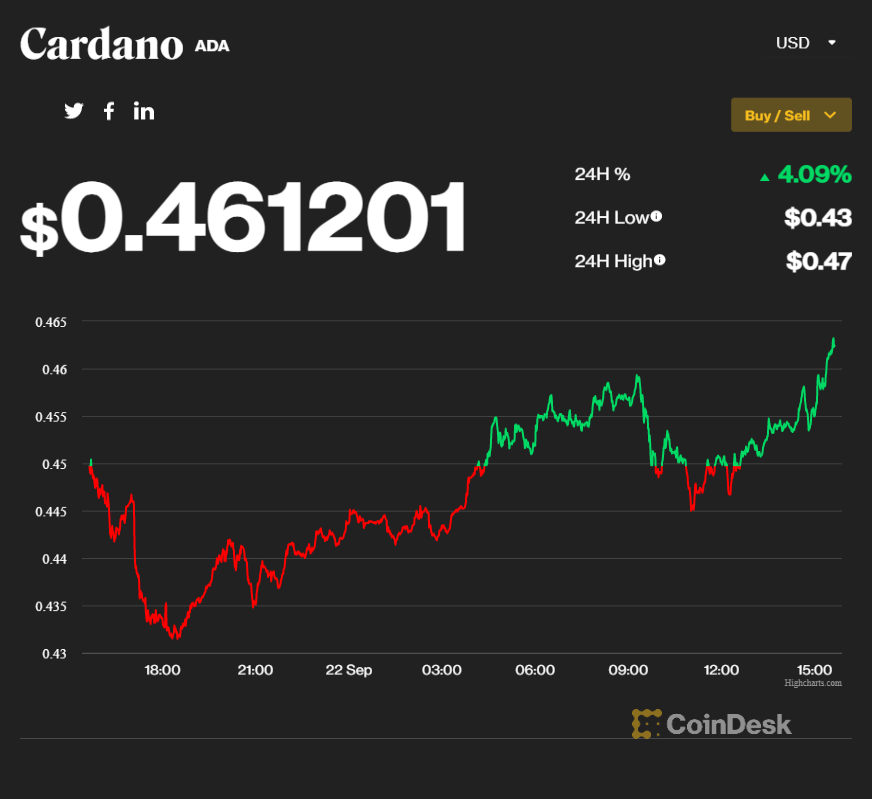Cardano’s Vasil Upgrade Marks an Important Milestone in the Blockchain’s Evolution

The average crypto watcher, aware that Ethereum has just completed its long-awaited transition to a proof-of-stake validating system, may be wondering what the overall takeaway is from Thursday’s Vasil hard fork upgrade on the Cardano blockchain.
The significance of Vasil’s rather technical set of changes, which improve the ledger’s programmability and its throughput potential, perhaps requires some zooming out to view a bigger picture.
Read more: What Cardano’s Highly Anticipated Vasil Hard Fork Will Bring
Cardano, sometimes touted as an “Ethereum killer,” is playing a long game. Critics of this process (split into “eras” named after Romantic poets, computer scientists and Enlightenment thinkers) often criticize the protocol for lagging behind other smart contract blockchains that already host thriving decentralized finance (DeFi) ecosystems and have amassed billions of dollars in total value locked.
But the early achievements of the foremost smart contract platform, Ethereum, are “brilliant but unstructured,” according to Aggelos Kiayias, chief scientist at Cardano builder Input Output Global (IOG). Smart contracts on Cardano are “different,” says Kiayias, who is also a professor in cryptography at the University of Edinburgh.
Smart contracts on Cardano
This is because Cardano is grounded in functional programming, a precise and mathematical way to write code that uses immutable data to tell the program exactly what to do, as opposed to achieving results through objects that alter a program’s state.
“I think many people had difficulties when smart contracts were launched in Cardano because they were hoping there would be a simple way to immediately port complex contracts from Ethereum to Cardano,” Kiayias said in an interview with CoinDesk. “But it requires a familiarity with functional programming and having to rethink, what would be the best way to program things in this new environment?”
For Kiayias, not only is functional programming a simple and natural approach to take, but when it comes to critical infrastructure it makes perfect sense. That’s because the intent of a computer program then becomes very clear and easy to verify. This simplicity also invites the possible automation of that verification. And while some investment of time is required, Kiayias said the intricacies of Cardano’s functional-based Plutus script can be simplified using domain-specific languages such as Marlowe.
Cardano is not the only blockchain to prize formal verification of smart contracts; the Tezos blockchain was also designed with this in mind. These days, however, such concerns may have fallen out of fashion amid the breathless rush of DeFi.
Bitcoin in the blood
Another fundamental difference between Cardano and most other layer one smart contract chains is its choice to use a design borrowed from Bitcoin.
Unlike Ethereum, which uses an account-based model rather like a bank’s, Cardano is based on the “unspent transaction output” (UTXO) system, a way of calculating what’s held in bitcoin wallets by keeping tabs on the change left over when fractions of coins are spent. But Cardano extends this practice so it’s not constrained by the Bitcoin blockchain’s data limits, an approach known as “extended unspent transaction outputs” (EUTXO).
This design was a natural fit for a deterministic functional approach and comes with important advantages, explained Kiayias.
“Either a transaction fits the current extended UTXO set and spends some UTXOs and introduces others, or it doesn’t fit,” he said. “So I have this deterministic assurance with how my transaction is going to interact with the blockchain state and not be modified by any other transactions.”
This is not the case for an account-based model like Ethereum, Kiayias pointed out. “In this case, I cannot fully predict how my transaction is going to interact with the blockchain state because other transactions can be ‘sandwiched’ before my transaction, modifying it, and then my transaction is basically engaging with a state that did not exist when I issued it. This actually makes a huge difference for smart contracts.”
Security at scale
Tying this back to the changes being implemented by Vasil, Cardano’s UTXO model will be more easily referred to, keeping more load off the chain, which is better for scaling and is also preferable from a security perspective.
“The Vasil upgrade will make it feasible to refer to UTXOs, and there’s substantial space savings because of that,” Kiayias said. “So while in theory it’s a small bookkeeping consideration, it’s a huge advantage in practice.”
Kiayias said it’s nothing new in the world of technology to see people rushing forward, which has arguably turned DeFi into a kind of hacker’s playground.
“If I want to improve usability or speed, I can always do better than you by sacrificing security,” Kiayias said, defending Cardano’s methodical approach and painstaking process of academic peer review.
“But I think we always need a scientific way of assessing the security of systems,” he added.
The Vasil hard fork is expected to activate at the end of the current epoch (at approximately 21:44 UTC) and will be finalized five days later on Sept. 27. Its native cryptocurrency, ADA, is up around 4% over the past 24 hours, trading at 46 cents at time of publication.







 Bitcoin
Bitcoin  Ethereum
Ethereum  Tether
Tether  USDC
USDC  Dogecoin
Dogecoin  TRON
TRON  Cardano
Cardano  Chainlink
Chainlink  Stellar
Stellar  Bitcoin Cash
Bitcoin Cash  LEO Token
LEO Token  Hedera
Hedera  Litecoin
Litecoin  Monero
Monero  Dai
Dai  OKB
OKB  Cronos
Cronos  Ethereum Classic
Ethereum Classic  Gate
Gate  VeChain
VeChain  Cosmos Hub
Cosmos Hub  Algorand
Algorand  KuCoin
KuCoin  Stacks
Stacks  Tether Gold
Tether Gold  Zcash
Zcash  Theta Network
Theta Network  IOTA
IOTA  Tezos
Tezos  TrueUSD
TrueUSD  NEO
NEO  Polygon
Polygon  Ravencoin
Ravencoin  Dash
Dash  Decred
Decred  Synthetix Network
Synthetix Network  Zilliqa
Zilliqa  Qtum
Qtum  0x Protocol
0x Protocol  Basic Attention
Basic Attention  Siacoin
Siacoin  Holo
Holo  DigiByte
DigiByte  Enjin Coin
Enjin Coin  Nano
Nano  Ontology
Ontology  Status
Status  Hive
Hive  Waves
Waves  Lisk
Lisk  Pax Dollar
Pax Dollar  Steem
Steem  Numeraire
Numeraire  NEM
NEM  BUSD
BUSD  Huobi
Huobi  OMG Network
OMG Network  Bitcoin Gold
Bitcoin Gold  Ren
Ren  Energi
Energi  Bitcoin Diamond
Bitcoin Diamond